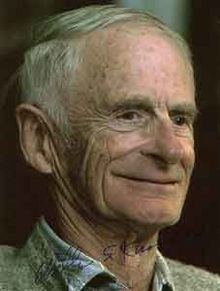Fields Chemistry | Role Chemist Name William Knowles | |
 | ||
Born June 1, 1917Taunton, Massachusetts, U.S. ( 1917-06-01 ) Institutions Thomas and Hochwalt LaboratoriesMonsanto Company Known for Chiral phosphine ligands that proved effective in the enantioselective synthesis of L-DOPA Similar People Ryoji Noyori, Karl Barry Sharpless, Henri B Kagan, Elias James Corey | ||
William Standish Knowles | Wikipedia audio article
William Standish Knowles (June 1, 1917 – June 13, 2012) was an American chemist. He was born in Taunton, Massachusetts. Knowles was one of the recipients of the 2001 Nobel Prize in Chemistry. He shared half the prize with Ryōji Noyori for their work in asymmetric synthesis, specifically for his work in hydrogenation reactions. The other half was awarded to K. Barry Sharpless for his work in oxidation reactions.
Contents
- William Standish Knowles Wikipedia audio article
- William Standish Knowles I was born in Taunton Massachusetts on June 1 1917 b
- Education
- Awards and honors
- Nobel Prize
- Personal life
- References
William Standish Knowles: I was born in Taunton, Massachusetts on June 1, 1917, b ......
Education
Knowles attended Berkshire School in Sheffield, Massachusetts. He led his class academically and upon graduation was admitted to Harvard University after passing the College Board exams. Feeling that he was too young to go to college, Knowles spent a year at Phillips Academy in Andover, Massachusetts. At the end of the year, he captured his first award in chemistry, the school's $50 Boylston Prize.
After his year in preparatory school, Knowles attended Harvard, where he majored in chemistry, focusing on organic chemistry. He received his undergraduate degree in 1939, and attended Columbia University for graduate school.
Awards and honors
Nobel Prize
He shared half of the Nobel Prize in Chemistry in 2001 with Ryōji Noyori for "their work on chirally catalysed hydrogenation reactions". The other half of the prize was awarded to K. Barry Sharpless for the development of a range of catalytic asymmetric oxidations. Knowles developed one of the first asymmetric hydrogenation catalysts by replacing the achiral triphenylphosphine ligands in Wilkinson's catalyst with chiral phosphine ligands. This experimental catalyst was effective for enantioselective synthesis, achieving a modest 15% enantiomeric excess.
Knowles was also the first to apply enantioselective metal catalysis to industrial-scale synthesis; while working for the Monsanto Company he developed an enantioselective hydrogenation step for the production of L-DOPA, utilising the DIPAMP ligand.
Personal life
Following his retirement in 1986, Knowles resided in Chesterfield, Missouri, a suburb of St. Louis. In retirement he restored native prairie grasses on a 100-acre farm that his wife had inherited. He was married to his wife, Nancy, for 66 years and had four children, Elizabeth, Peter, Sarah and Lesley McIntire. He also had four grandchildren. Knowles died in Chesterfield on June 13, 2012 at age 95. He and his wife had previously stated that their farm would be donated to be converted into a city park after their deaths.
